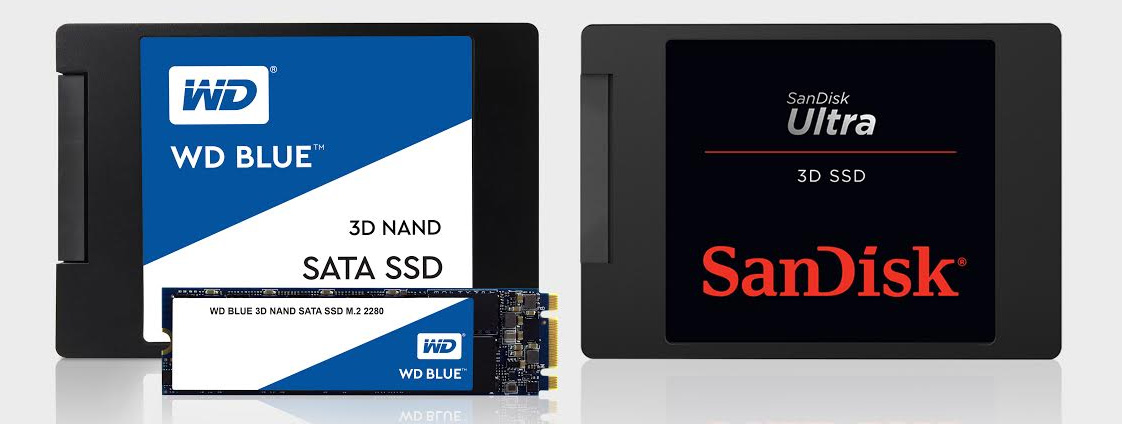WD, Sandisk Out Their First 64-Layer NAND SSDs
In a joint announcement, Western Digital and its subsidiary SanDisk outed their first SSDs with 64-layer NAND technology. The new consumer products utilize BiCS FLASH, the highly anticipated 3D stacking technology that’s used to increase storage density and increase endurance.
The WD Blue 3D and SanDisk Ultra 3D SSD families come to market with identical speeds and feeds. Capacities range from 250GB to 2TB with stops along the way at 500GB and 1TB. WD told us to expect up to 560 MBps sequential read and 530 MBps sequential write speeds from the 64-layer 3-bit per cell 3D NAND used in the drives. We don’t expect a significant performance loss from the smaller capacity models.
BiCS FLASH will ship in both 256Gbit and 512Gbit die capacity sizes, and that allows manufacturers to keep parallelism high in smaller capacity models. We reached out for more details but were unable to confirm what controller Western Digital paired with the new flash technology. Further, we could not confirm the existence of DRAM in these new products.
The WD Blue 3D NAND SATA SSD adds more product SKUs, from an M.2 single-sided 2280 form factor. Many new thin and light notebooks ship with only an M.2 connector for storage, so it’s nice to have a mainstream upgrade path.
Western Digital didn’t give us price points for all capacity sizes, but we know all three 250GB products carry a $100 MSRP with a three-year warranty. Expect products to ship in Q3 2017.
Get Tom's Hardware's best news and in-depth reviews, straight to your inbox.

Chris Ramseyer was a senior contributing editor for Tom's Hardware. He tested and reviewed consumer storage.
-
Karadjgne And after a moment of stunned silence, the boardroom at Samsung HQ just went ballistic...Reply -
Tanyac "560 MBps sequential read and 530..."Reply
Don't know why Samsung would be worried in the slightest. I can't recall when they last made M.2 drives that slow..
Everyone should move up to the 3500/2500 speeds Samsung produces so pressure can be applied to force Samsung to be more competitive with pricing. -
Matko_1 Sounds good. M.2 speeds aren't even close to being properly used by most programs. You'd think M.2 drives would literally be 4-7 times faster due to theoretical/bench speeds, but alas they're not in most real world situations.Reply -
Karadjgne Sustained sequential write speeds for the 960evo is just 300MBps on the 250 and 600MBps for the 500, the 3200MBps is only the SLC cache speeds. If the WD/SanDisk can write 530 sustained, that'd be a bonus for laptop use at its price point unless you can afford the bump upto a 1Tb which pulls 1200MBps sustained. That's all I was thinking.Reply -
Karadjgne Actually no, that comes directly from Anandtech, so if you'll tell me they are wrong or 'pulling numbers out their A..", be my guest.Reply
http://www.anandtech.com/show/10833/the-samsung-960-evo-1tb-review -
irish_adam @Karadjgne How much sustained disk writing do you do on your laptop? the sustained read and random performance would be far more useful and thats where the evo trounces this driveReply -
Karadjgne Might actually wanna look at the post, it links to a comparison between the 250/500/1Tb not a 256 or 512 as those aren't EVO sizes, so that's not what I said. I also said nothing about 4k random read/writes, I only said sustained, which the chart quite clearly shows, listed right under the SLC cache speeds. The sustained write for a 250Gb 960evo is 300MBps, it's only the SLC cache write that's 3200MBps which is great for small file transfers but long downloads or large file usage is going to suffer.Reply
-
alextheblue Reply
Those crazy high numbers Samsung advertises are for the SLC cache as Karadjgne points out. Don't get me wrong, I think their SLC caching is great... I use nothing but Samsung SSDs. My next SSD will also be Samsung more than likely. But most consumers and OEMs don't care about some burst cache. $100 vs $150? At 2/3 the price I think they'll accept "good enough" SSD speeds for the M.2 form factor. It's easier to cram into compact devices vs a 2.5" SATA drive, but without the traditional "M.2 form factor tax". OEMs will no doubt get even better pricing.19751982 said:"560 MBps sequential read and 530..."
Don't know why Samsung would be worried in the slightest. I can't recall when they last made M.2 drives that slow..
Everyone should move up to the 3500/2500 speeds Samsung produces so pressure can be applied to force Samsung to be more competitive with pricing.
Samsung shouldn't be "worried" but they will be forced to bring pricing down a little. They can afford to charge a premium but not a 50% premium, when real-world performance is *relatively* close (not identical!) to these new cheaper M.2 drives. For example if Samsung dropped their price to $120 that would be stellar and I'd recommend the Samsung drive. I suspect that is the sort of scenario we'll see. -
Karadjgne It really takes a benchmark to tell the difference in speeds for almost all the SSDs (not counting the Pro version NVMe drives) unless doing something repetitive and long, switching or comparing side by side between the Samsung and the WD, realistically they aren't much different. For most consumers, with a single ssd as boot, there is no comparison, so with price being the last resort, 'good enough' will become king. Samsung makes the best, no bones about that, but how many really will keep a 120Gb ssd through several builds, maybe as long as the 10-15 years of useful life most SSDs show now? How long will the 250's last before windows 15 comes out using 200Gb and talks to you? Fast and cheap is all that really matters anymore, best is for those who can afford to throw away money.Reply
